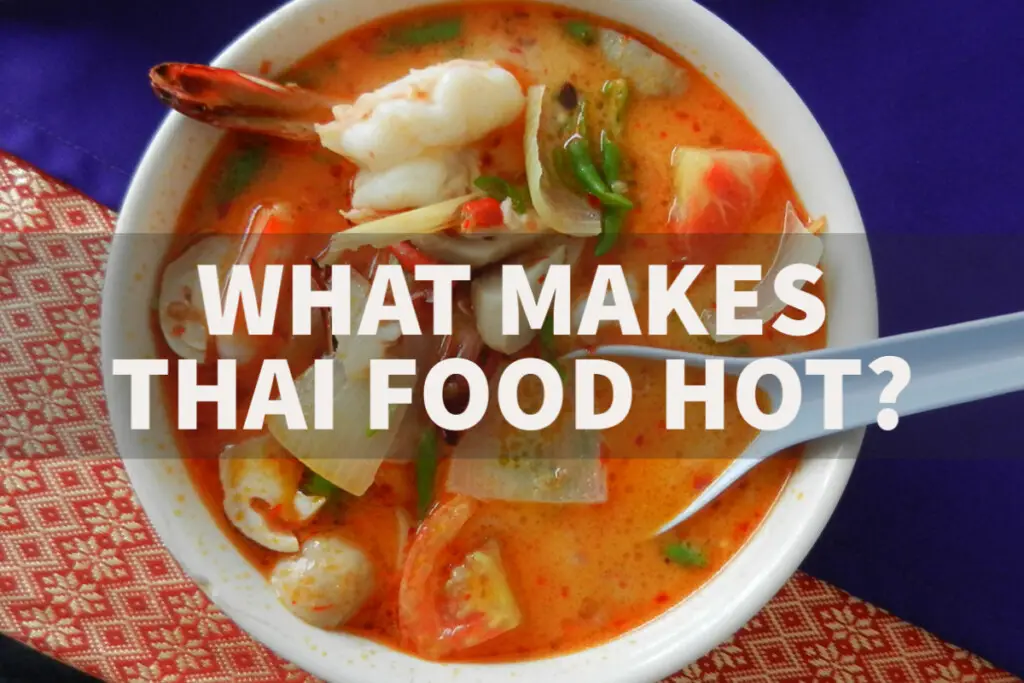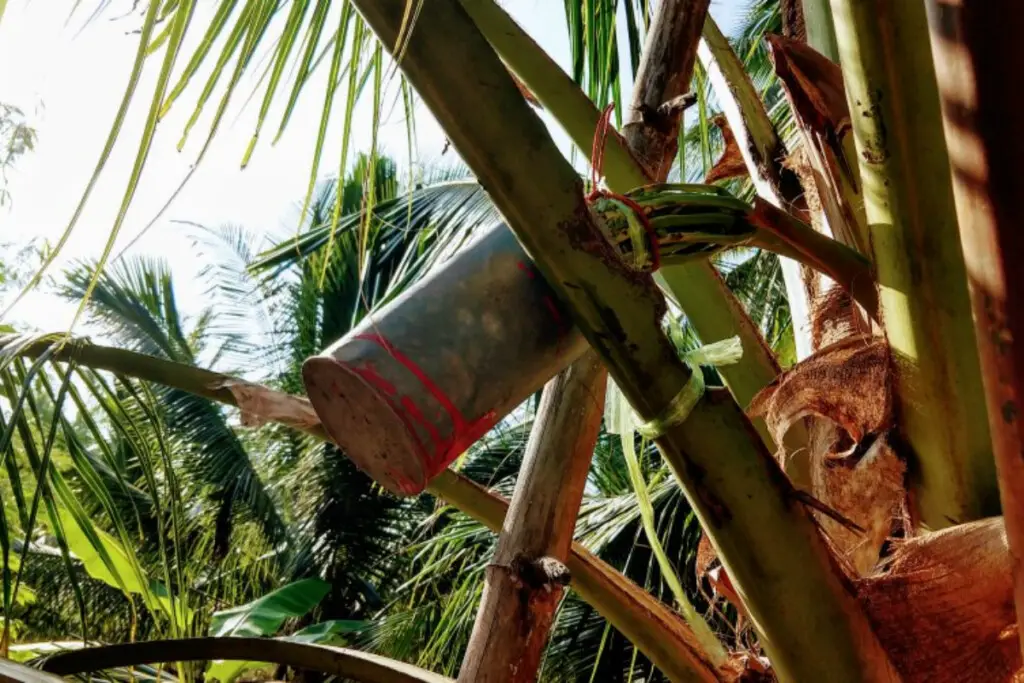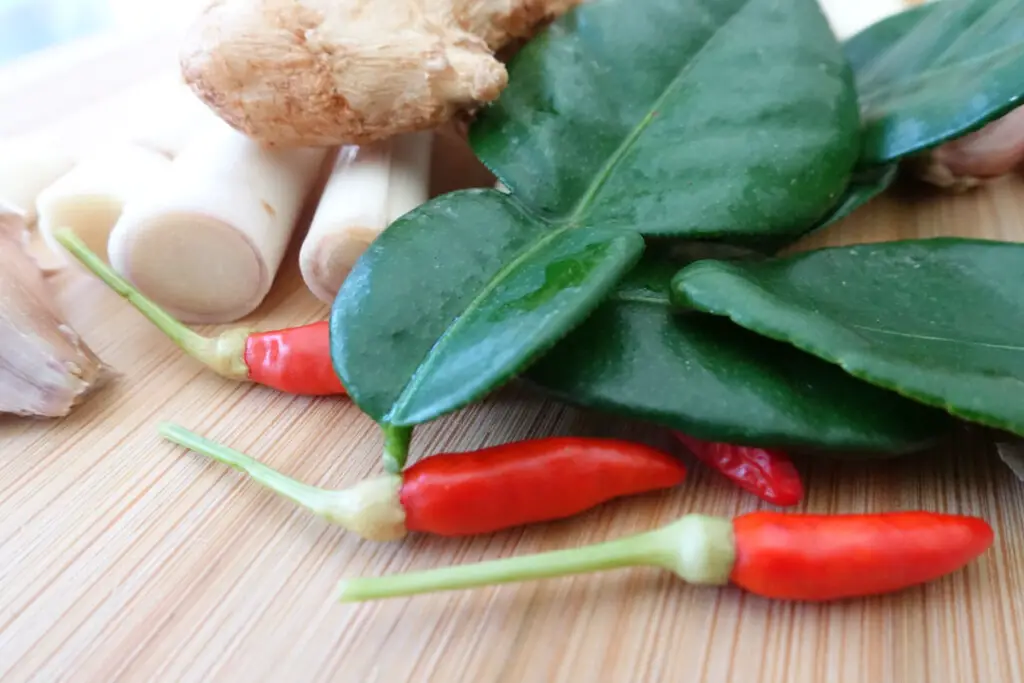This post may contain affiliate links.
Most Thai foods have a fair amount of kick and some people refer to this as “spicy”. In this post we discuss what makes Thai food spicy. Thai food actually uses few spices, nothing compared to the spice array used in Indian food, Nepalese food, or even in the British dish, Christmas pudding. However, Thai food can be “hot”. Not all Thai dishes are “hot” or “spicy’ but they are very flavourful and aromatic thanks to the delicious flavours and fragrances of aromatics like kaffir lime leaf and lemongrass.

Spicy Thai Food
The “spicy” hit in Thai food comes from chillies, peppercorns, and even ginger, galangal and garlic can be considered spicy by some.
Some Thai dishes do use other spices such as turmeric in khao soi. Thai curry pastes can also contain spicy elements.
The chillies can be fresh or dry, ground or whole and contain a chemical called capsaicin. This chemical gives all peppers “heat” at various levels.
Ginger contains a chemical called gingerol. Turmeric and galangal are also members of the ginger family.
The exact species used from these two families will give the level of “spiciness”
The 5 Flavours Of Thai Food

The 5 flavours of Thai food are often listed as sweet, salty, sour, bitter, and umami. Umami is a deep savouriness.
Thai dishes create perfect balance and harmony between these 5 flavours.
Elsewhere you will see the 6 flavours listed as sweet, sour, creamy, salty, spicy, and bitter. It seems opinions vary!
Everyone agrees that in Thai food there must be balance. This makes Thai cuisine one of the most delicious in the world.
- Sweet may come from sugar, often palm sugar or coconut sugar. Both are made in Thailand
- Sour can come from lime juice, vinegar, or tamarind.
- bitter flavours are found in a very few bitter ingredients, such as bitter gourd. It’s not a common ingredient.
- Umami tastes in Thai food are typified b soy sauce, in sweet, light, and dark variations.
- Creamy tastes come from coconut milk and coconut cream.
- Salty flavourings in Thai food include fish sauce (nam pla), fish pastes, soy sauce, or sea salt.
- The” spicy” or “hot” sensations in Thai food come from chilly peppers, black pepper, members of the ginger family, and even garlic is considered “spicy” by some.

Other flavours in Thai Food
- The aniseed-like flavour of Thai basil is a common flavour in Thai food, both in salads and cooked dishes.
- Kaffir lime leaves are highly fragrant yet not sour as lime juice and zest are.
- Lemon grass offers a strong lemony citrus perfume to a dish.
How Spicy Are Thai Chillies?

The Scoville Scale, created in 1912 by Willian Scoville, it measures how “hot” or “spicy” a chili pepper is. Examples of Scoville scale measurements are below.
- Pure Capsaicin, the hottest possible, 15-16,000,000 Scoville Heat Units.
- Thai chili pepper, 50,000 to 100,000 Scoville Heat Units
- Bell (sweet, or capsicum) ZERO Scoville Heat Units.
Thai chili peppers are pretty hot in general, but there are several varieties used in Thailand.
The heat can be in the curry paste, in hot chili oil, added as fresh chili peppers or added as a condiment.
Thai food uses a lot of condiments and several contain extra spiciness and chilies.
Non Spicy Thai Food
If you really can’t handle chillies, most Thai restaurants will give you the option to order your dish “non-spicy” this simply means they won’t add chillies, your dish should still contain the usual spices for flavour. If you need to ask for this in Thai (your server will speak English 99% of the time) say “mai sai prik” which means Don’t add chilli.
If you'd like to hire a car during your stay, use this car rental comparison tool to find the best deal!
Please check out our Pinterest account for loads of food and recipes from around the world!









